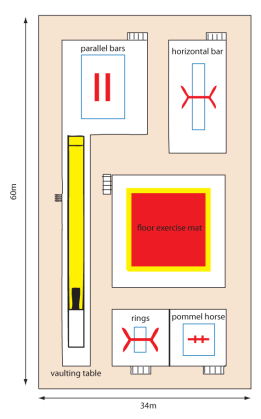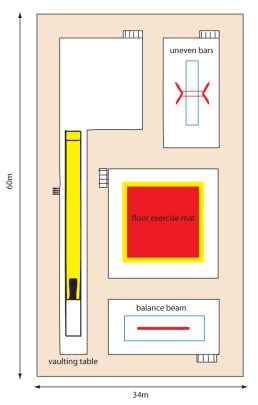Introduction
Gymnastics is the name given to a series of exercises practised by men and women. Emphasis is placed on strength, dexterity and artistry. The disciplines in gymnastics recognised by the Federation International de Gymnastique (FIG) and Gymnastics Australia are artistic, rhythmic, aerobic, trampoline and acrobatic.
Artistic gymnastics - men and women
Men and women - floor exercisesFloor exercises consist of various ballet and tumbling movements (including jumps, somersaults and handstands) performed without apparatus. Women's routines are performed with musical accompaniment, men's routines without it. The standard floor performance area is 12m x 12m. The safety zone is a 2m zone around the performance area and the border and kept totally free.
Men - horizontal bars
This routine is performed on a single steel bar suspended 2.8m above the floor mat. The routine requires continuous swinging motions around the bar with frequent changes in direction and in grip. In the dismount the athlete casts himself off the bar, soars through the air an d then makes a controlled landing. The landing mat is 12m x 12m.
Men - parallel bars
This routine is performed on two flexible parallel rails 2m above the ground and 42cm-52cm apart from each other. The routine is a series of swinging, balancing, and airborne moves. The landing mat is 11m x 4.5m.
Men - pommel horse
The routine is performed on a leather-covered apparatus, in the centre of which are inserted two pommels, or handles, 40cm-45cm apart. The routine consists of a series of continuous swinging and circular motions with the torso and legs, executed as the athlete travels from one end of the horse to the other, using only his hands for support. The landing mat is 4m x 4m.
Men - rings
The routine is performed while grasping one wooden ring in each hand, with the rings suspended from straps and hung parallel to each other 2.8m above the floor mat. The routine combines static positions with rapid movements designed to test strength and precision. The landing mat is 5m x 2m.
 Men - vault
Men - vault
This discipline involves an apparatus, known as a vault, measuring 1.2m long and 1.35m high and has no pommels. The athlete runs down a runway (maximum 25m long) toward the vault, approaching it lengthwise. He then takes off from a springboard, places both hands on the surface of the vault, then completes the flight with an acrobatic airborne manoeuvre and a controlled landing. The landing mat is 6m x 2m.
Women - vault
The women's routine is the same as in the men's event, except that the vault, similar in shape and size to that used by the men, is lowered to a height of 1.2m and is approached from the side. The landing mat is 6m x 2.5m.
Women - uneven bars
This routine is performed on a set of two flexible bars a maximum of 1.435m apart from each other at different heights. The upper bar is 2.5m from the floor. The lower bar, parallel to it, is between 1.7m above the floor. The routine demands continuous swinging, releasing and changing of direction over, under and between the bars with a mount and dismount. The landing mat is 14m x 2m.
Women - beam
The balance beam is a routine performed on a single beam 10cm wide, 5m long, and 1.2m off the ground. The routine consists of continuous tumbling moves, turns, jumps and leaps. A mount and dismount are required. The landing mat is 17m x 4m.
Rhythmic gymnastics
Rhythmic gymnastics is a sport in which single competitors, pairs, trios or groups perform choreographed routines while manipulating apparatus - ball, hoop, ribbon, clubs or ribbon. Routines are choreographed to music using elements of ballet, gymnastics and theatrical dance while handling the apparatus.All routines are performed on a 13m square carpeted floor with a 50cm border. Overall size is 14m2. There is a 2m safety zone around the floor. The carpet may be lightly padded. The outer edge of the border marking is defined as out of bounds.
As high throws occur while handling the apparatus, a minimum ceiling height of 8m is required for international competitions. A ceiling height of 10m to 12m is recommended.
Aerobic gymnastics
Aerobic gymnastics is a competitive sport that combines aerobic choreography and gymnastics elements to upbeat music. The standard performance area is 7m x 7m with a 1m safety border. The floor is parquet, laminate or synthetic.Acrobatic gymnastics (sport acrobatics)
Acrobatic gymnastics is choreographed to music and consists of dance, tumbling and partner skills. The partner skills are divided into two categories - balance and tempo. Tempo skills all incorporate flight, such as when the base partner tosses the top for double saltos. Balance skills are static holds with the base partner supporting the top. There are five events in acrobatic gymnastics:- men's pairs
- women's pairs
- mixed pairs
- women's group (trio)
- men's group (quadruples)
Trampoline gymnastics
Trampoline gymnastics or sports has three apparatus:- individual trampoline (TRP) and synchronised trampoline (SYN)
- double-mini trampoline (DMT)
- tumbling (TUM)
End decks and spotter mats must be provided in all trampoline events. One spotter mat must be provided for each trampoline, as specified in the FIG Apparatus Norms.
